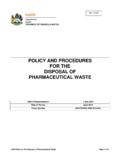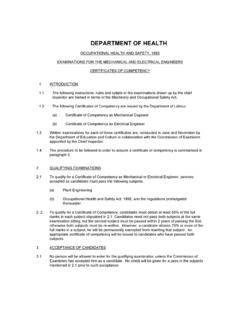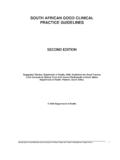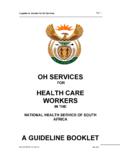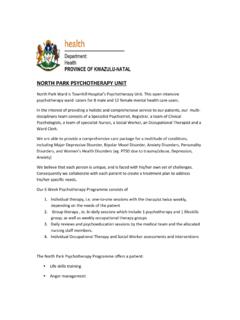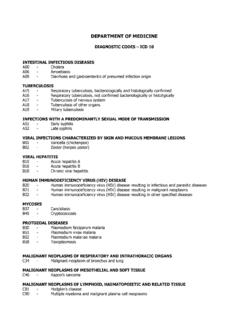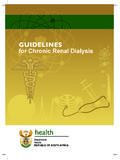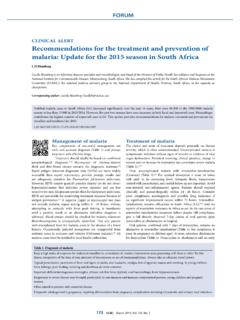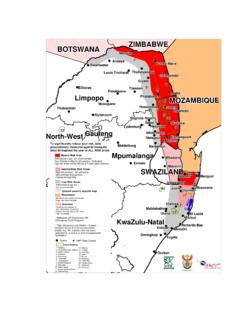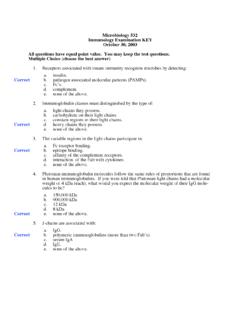Transcription of VACCINE INFOR MATION - Department of Health
1 FOR PARENTS & CAREGIVERSVACCINE INFORMATIONNATIONAL INSTITUTE FOR COMMUNICABLE DISEASESD ivision of the National Health Laboratory ServiceFirst Edition November 2016 Editors-in-ChiefNkengafac Villyen Motaze (MD, MSc, PhD fellow), Melinda Suchard (MBBCh, FCPath (SA), MMed)Edited by: Cheryl Cohen, (MBBCh, FCPath (SA) Micro, DTM&H, MSc (Epi), Phd) Lee Baker, (Dip Pharm)Lucille Blumberg, (MBBCh, MMed (Micro) ID (SA) FFTM (RCPS, Glasgow) DTM&H DOH DCH)Published by:Ideas Wise and Wonderful (IWW) for National Institute for Communicable Diseases (NICD)First Edition: Copyright 2016 Contributions by:Clement Adu-Gyamfi (BSc Hons, MSc), Jayendrie Thaver (BSc), Kerrigan McCarthy, (MBBCh, FCPath (SA), DTM&H, MPhil (Theol)Kirsten Redman (BSc Hons), Nishi Prabdial-Sing (PhD), Nonhlanhla Mbenenge (MBBCh, MMED) Philippa Hime (midwife), Vania Duxbury (BSc Hons), Wayne Howard (BSc Hons) Acknowledgments.)
2 Amayeza, VACCINE Information Centre ( )Centre for Communicable Diseases Fact Sheets ( )World Health Organization Fact Sheets ( )National Department of Health , South Africa ( )DisclaimerThis book is intended as an educational tool only. Information may be subject to change as schedules or formulations are updated. Summarized and simplified information is presented in this booklet. For full prescribing information and contraindications for vaccinations, please consult individual package inserts. There has been no financial contribution from any pharmaceutical company to the compilation of this booklet.
3 The authors accept no liability from any actions related to information presented in this and bound in South Africa by IWWISBN 978-0-620733-15-1 NATIONAL INSTITUTE FOR COMMUNICABLE DISEASESD ivision of the National Health Laboratory ServiceContentsSection 1 IntroductionHow do vaccines work?Page 02 VACCINE schedule in South AfricaPage 04 WorkpagesPage 05 Section 2 Vaccines included in the expanded programme on Immunization of South AfricaVaccines first given at birth Polio vaccinePage 08 Tuberculosis vaccinePage 10 Vaccines first given at 6, 10, and 14 weeksDiphtheria, tetanus, pertussis, Haemophilus influenzae b, hepatitis B.
4 Polio vaccinesPage 12 Pneumococcal conjugate vaccinePage 16 Rotavirus vaccinePage 17 Vaccines first given at 6 and 12 monthsMeasles vaccinePage 18 Vaccines first given at 9 yearsHuman papillomavirus vaccinesPage 20 Section 3 Additional vaccines Influenza vaccinePage 22 Measles, mumps, rubella VACCINE (MMR)Page 24 Chicken pox (varicella) VACCINE Page 26 Meningococcal VACCINE Page 27 Section 4 Frequently asked questions and helpful tips regarding vaccinationFrequently asked questions about allergies, mass campaigns and missed dosesPage 30 Hints and tips for parents and caregivers for preparing for vaccination visitsPage 33 Glossary of termsPage 34 AbbreviationsPage 35 Appendix A: Department of Health Vaccination SchedulePage 35 Appendix B.
5 Comparison of State and private schedulePage 37 VACCINE information for Parents & Care-giversNATIONAL INSTITUTE FOR COMMUNICABLE DISEASESD ivision of the National Health Laboratory ServiceVaccines are widely acknowledged to be the most successful medical advance ever. Vaccines continue to save hundreds of thousands of lives annually. History is full of descriptions of the devastation wrought on populations by infectious diseases before the age of vaccination. Huge numbers were killed by diseases like measles and smallpox, and hundreds of thousands left paralyzed by polio.
6 The demonstration in the 1970 s that smallpox could be wiped out by vaccination led to the introduction of the Expanded Program on Immunization by the World Health Organization in 1974. Universal vaccination introduced global access to vaccines against the big six diseases polio, tuberculosis, measles, diphtheria, pertussis and tetanus. Huge strides have been made in combating these diseases using vaccination. Many of these diseases are now uncommon, and mothers today may have never even heard of friends who have lost children due to illnesses like measles or diphtheria.
7 The success of vaccines may therefore lead to complacency and a false sense of comfort, unless we remember the devastation that these diseases caused in years gone by. In some areas of Africa, it was customary for mothers not to name their babies until the measles season had passed, for fear they would not live through the fear of measles is no longer with us, and yet it is only by a continued sense of urgency that we can ensure that VACCINE -preventable diseases do not South Africa, newer vaccines have been introduced as they have been developed, allowing protection against Haemophilus influenza type b, Streptococcus pneumoniae, hepatitis B.
8 Human papillomavirus and rotavirus. These vaccines are making a large impact on the Health of South African children. We hope to see even more vaccines developed and implemented in the years to come. We hope you find this booklet helpful to find information regarding the vaccines your child/children will get at each stage of their development. We have also included workpages so that you can remind yourself when they will be due for their next vaccination. We include answers to some frequently asked questions and misconceptions about vaccines as well as links to where you can find further reliable is always better than cure.
9 Vaccines are the best prevention we can offer our children against infectious diseases let s make VACCINE -preventable disease a distant memory for our children s generation. Dr Melinda SuchardHead, Centre for Vaccines and ImmunologyNational Institute for Communicable DiseasesForewordof VaccinesOctober, 2016 VACCINE information for Parents & Care-givers01 NATIONAL INSTITUTE FOR COMMUNICABLE DISEASESD ivision of the National Health Laboratory ServiceSection 1of VaccinesIntroduction02 VACCINE information for Parents & Care-giversNATIONAL INSTITUTE FOR COMMUNICABLE DISEASESD ivision of the National Health Laboratory Service02 VACCINE information for Parents & Care-giversHow do vaccines work?
10 The process of vaccination involves giving a person small, harmless amounts of an infectious agent (for example a virus) in order for the immune system to see it and prepare itself for the next time it meets the same infectious agent. Some vaccines are weakened forms of live infectious agents (called live attenuated vaccines) and some are inactivated parts of the infectious agent. Vaccines are highly safe and effective at preventing diseases. Vaccines are more studied for safety than any other medication. Each VACCINE has been described in this booklet according to the usual age at which it is first given to children in South Africa.
